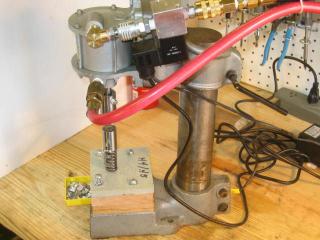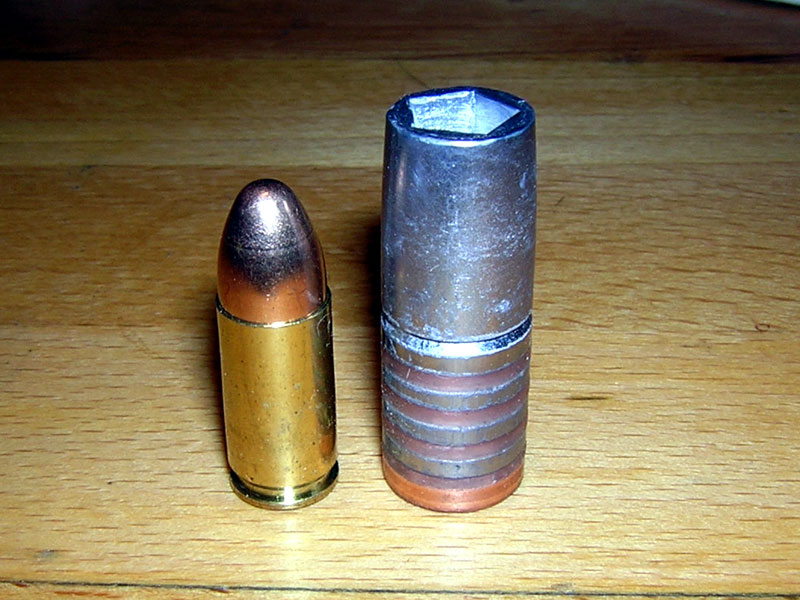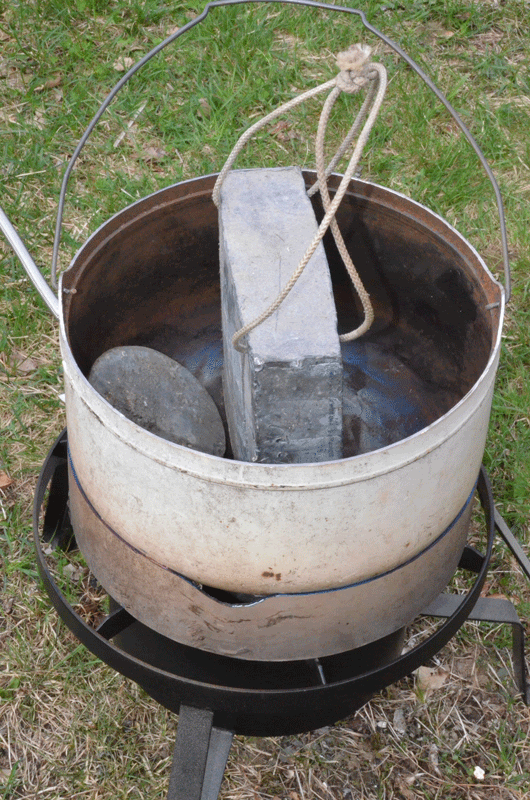-
If you enjoy the forum please consider supporting it by signing up for a NES Membership The benefits pay for the membership many times over.
You are using an out of date browser. It may not display this or other websites correctly.
You should upgrade or use an alternative browser.
You should upgrade or use an alternative browser.
The Bullet Casting Info Megathread
- Thread starter Bob J
- Start date
Bob, you had given me a sample of a 700 grain bullet some time ago. Where did you get those? I thought that you had made them.
Nice! Can't wait to get this one in......![Smile [smile] [smile]](/xen/styles/default/xenforo/smilies.vb/001.gif)
Bob J
NES Member
Bob, you had given me a sample of a 700 grain bullet some time ago. Where did you get those? I thought that you had made them.
Got those from Ranger Rick..... Have been looking forward to getting this mold for a while..... BTW, did you see the FCIII pneumatic press setup over on cast boolits? It's about half way down the first page of this thread:
http://castboolits.gunloads.com/showthread.php?p=1190031#post1190031
Very interesting......;- )
Last edited:
wow!

Got my 700 grain mold today!! Yay.
Make up two of those FCIII air rams, and send one to me, please......

Got my 700 grain mold today!! Yay.
Make up two of those FCIII air rams, and send one to me, please......
Bob J
NES Member
I have to admit it's a pretty sweet setup.... Congrats on getting your mold..... Hopefully mine will be in soon....![Thinking [thinking] [thinking]](/xen/styles/default/xenforo/smilies.vb/010.gif)
![Thinking [thinking] [thinking]](/xen/styles/default/xenforo/smilies.vb/010.gif)
wow!

Got my 700 grain mold today!! Yay.
Make up two of those FCIII air rams, and send one to me, please......

That's a 9mm next to it.
Patriot
NES Member

That's a 9mm next to it.
What do you lube that with? Testosterone?
![Party [party] [party]](/xen/styles/default/xenforo/smilies.vb/021.gif)
Patriot
NES Member
I just came across the availability of this completed and corrected document.
"From Ingot to Target in pdf is now available with proper page numbering for your numerical printing pleasure."
From Ingot to Target: A Cast Bullet Guide for Handgunners in pdf. See post # 102.
http://castboolits.gunloads.com/showthread.php?t=36854&page=6
"From Ingot to Target in pdf is now available with proper page numbering for your numerical printing pleasure."
From Ingot to Target: A Cast Bullet Guide for Handgunners in pdf. See post # 102.
http://castboolits.gunloads.com/showthread.php?t=36854&page=6
Bob J
NES Member
Nice! Thanks for posting this Richard....![Smile [smile] [smile]](/xen/styles/default/xenforo/smilies.vb/001.gif)
![Smile [smile] [smile]](/xen/styles/default/xenforo/smilies.vb/001.gif)
I just came across the availability of this completed and corrected document.
"From Ingot to Target in pdf is now available with proper page numbering for your numerical printing pleasure."
From Ingot to Target: A Cast Bullet Guide for Handgunners in pdf. See post # 102.
http://castboolits.gunloads.com/showthread.php?t=36854&page=6
Jim I am having a heck of a time pushing those 700 grns through my star sizer w hornady checks on them,were they any easier for you?
I'm using an RCBS sizer. It's a bit of work to size them, but they go through OK.
Jim I am having a heck of a time pushing those 700 grns through my star sizer w hornady checks on them,were they any easier for you?
How long ago were they cast? Water dropped?
Sometimes it's easier for some of the bigger calibers to size as soon after casting as possible because they're easier to work with before they fully harden.
I always size the BIG bullets at least the next day after casting. They harden up pretty good.
And, how tough it is to push through a sizing ring depends on how much reduction in diameter you're going. .001 - .002 reduction isn't as bad as .003 - .004 in reduction.
Next time, don't leave them quite that long before running them, and report back as to whether that was easier.
And, how tough it is to push through a sizing ring depends on how much reduction in diameter you're going. .001 - .002 reduction isn't as bad as .003 - .004 in reduction.
Next time, don't leave them quite that long before running them, and report back as to whether that was easier.
Large mass of lead
A friend gave me a 67 pound block of lead. Today I decided to smelt it down, along with an 8 pound ingot, into more usable sized ingots.

I couldn't get the lead to melt. It was a little breezy but the corners that rested on the bottom of the pot didn't even begin to melt. I dropped a small chunk (a shotgun slug) into the pot and it melted. I guess the mass of the large ingot plus the wind just sucked all the heat away.
What should I do? Should I first melt some small ingots and then dip the large chunk into the molten lead? Should I find a less windy time? I know dukeinmaine melted down large blocks of lead. How long did it take to get the large pieces to melt?
A friend gave me a 67 pound block of lead. Today I decided to smelt it down, along with an 8 pound ingot, into more usable sized ingots.

I couldn't get the lead to melt. It was a little breezy but the corners that rested on the bottom of the pot didn't even begin to melt. I dropped a small chunk (a shotgun slug) into the pot and it melted. I guess the mass of the large ingot plus the wind just sucked all the heat away.
What should I do? Should I first melt some small ingots and then dip the large chunk into the molten lead? Should I find a less windy time? I know dukeinmaine melted down large blocks of lead. How long did it take to get the large pieces to melt?
Make one big bullet? Use a hand torch and melt the corners down, it will all begin to sit in the pot and you will be adding heat the whole time. I would get rid of that handle first though.
Last edited:
When we were doing those sailboat chunks, the trick we figured out was to INCREASE the molten lake in the pot. That adds surface area for melting your big block. The ultimate solution for the future is to never really empty your pot when casting ingots. I always leave 1" or better in the bottom, because of your issue. It also helps when working to avoid overheating the bottom of the pot when dealing with possible zinc issues. Because the 1" layer that you leave in the bottom has PERFECT contact with the bottom, it melts down very fast! When smelting wheel weight, I melt that bottom layer first, and then start adding handfuls of wheel weights. That goes the fastest for me. And, as said earlier, avoids over heating the bottom of the pot, which could cause any zinc (near the bottom) to melt.
Short term solution for you is to melt down some of the smaller ingots that you might have (you DO have some in storage, right?) until you get enough that the molten lake covers the bottom of the lead block. Then, expect at least 1/2 hour - 45 minutes for the serious melting to happen. It DOES take a while, but when it starts to go, it goes fast.
Short term solution for you is to melt down some of the smaller ingots that you might have (you DO have some in storage, right?) until you get enough that the molten lake covers the bottom of the lead block. Then, expect at least 1/2 hour - 45 minutes for the serious melting to happen. It DOES take a while, but when it starts to go, it goes fast.
Last edited:
Short term solution for you is to melt down some of the smaller ingots that you might have (you DO have some in storage, right?) until you get enough that the molten lake covers the bottom of the lead block. Then, expect at least 1/2 hour - 45 minutes for the serious melting to happen. It DOES take a while, but when it starts to go, it goes fast.
I took DukeInMaine's advice and started by melting a 2 pound ingot then a 4 pound ingot then the 8 pound ingot and then added the 67 pounder. I now have usable sized ingots. It took much longer than I expected however to melt the 67 pound ingot.
Thanks for your help.
If I were better at math, I would be able to do the calculations for how much propane (based on btu's) it takes to get all those ingots, plus the 67 pounder up to 600+ degrees.
One btu is the amount of heat that is required to raise one pound of water ONE DEGREE.
You might be able to imagine it this way. Take one gallon (8 pounds) of water and put it on your stove. If the water it 60 degrees F. and you want to bring it to a boil (212 degrees F.) then you will need about 1,200 BTUs to do this.
All combustible materials have a BTU rating. For instance, propane has about 15,000 BTUs per pound. Charcoal has about 9,000 BTUs per pound and wood (dry) has about 7,000 BTUs per pound. This gives you an idea of how much fuel you'd need to melt something.
A 20 pound propane tank, full, has 300,000 btu's of heat potential.
Your burner has a certain btu output (ability to burn the propane), but some of that heat is lost when the heat goes up the sides of the pot, etc. Not all of the heat is transferred to melting the lead directly.
http://www.walmart.com/ip/King-Kook...gle-Burner-Outdoor-Cooker-Camp-Stove/10661038
This unit has a 54,000 btu/hour rating. In six hours, it will empty a 20 pound propane tank, at full roar.
So, 100 pounds of lead, raising the temp 550 degrees = 55,000 btu (if it were water and all heat was put into it), should take an hour! That's a long time at full roar!
Bottom line is that you'll burn some significant amount of propane to melt 100 pounds of lead. And, it will take a while to get it going. And, you'll need a pretty good pond/puddle of molten lead if you are going to melt down a BIG chunk of lead. Just to get the surface area contact.
One btu is the amount of heat that is required to raise one pound of water ONE DEGREE.
You might be able to imagine it this way. Take one gallon (8 pounds) of water and put it on your stove. If the water it 60 degrees F. and you want to bring it to a boil (212 degrees F.) then you will need about 1,200 BTUs to do this.
All combustible materials have a BTU rating. For instance, propane has about 15,000 BTUs per pound. Charcoal has about 9,000 BTUs per pound and wood (dry) has about 7,000 BTUs per pound. This gives you an idea of how much fuel you'd need to melt something.
A 20 pound propane tank, full, has 300,000 btu's of heat potential.
Your burner has a certain btu output (ability to burn the propane), but some of that heat is lost when the heat goes up the sides of the pot, etc. Not all of the heat is transferred to melting the lead directly.
http://www.walmart.com/ip/King-Kook...gle-Burner-Outdoor-Cooker-Camp-Stove/10661038
This unit has a 54,000 btu/hour rating. In six hours, it will empty a 20 pound propane tank, at full roar.
So, 100 pounds of lead, raising the temp 550 degrees = 55,000 btu (if it were water and all heat was put into it), should take an hour! That's a long time at full roar!
Bottom line is that you'll burn some significant amount of propane to melt 100 pounds of lead. And, it will take a while to get it going. And, you'll need a pretty good pond/puddle of molten lead if you are going to melt down a BIG chunk of lead. Just to get the surface area contact.
Last edited:
Great info here.
Thanks Orville,
This confirms what I have been thinking. There also appear to be lots of losses in the process. For example, if I had put a lid on the pot to hold in more heat then I think the lead would have melted quicker. It took quite a while before the top of the block of lead was too hot to touch. When the chunk really started melting on the bottom I cut the rope handle off and stuck my thermometer in the hole left by the handle. The temperature at the top was below 400 degrees. At this point I decided to get more surface contact with the molten lead so I carefully laid the remains of the large block on its side. The molten lead solidified almost immediately. It took quite a while before things got going again.
This confirms what I have been thinking. There also appear to be lots of losses in the process. For example, if I had put a lid on the pot to hold in more heat then I think the lead would have melted quicker. It took quite a while before the top of the block of lead was too hot to touch. When the chunk really started melting on the bottom I cut the rope handle off and stuck my thermometer in the hole left by the handle. The temperature at the top was below 400 degrees. At this point I decided to get more surface contact with the molten lead so I carefully laid the remains of the large block on its side. The molten lead solidified almost immediately. It took quite a while before things got going again.
Share:

![Laugh [laugh] [laugh]](/xen/styles/default/xenforo/smilies.vb/012.gif) Boolit envy.
Boolit envy.